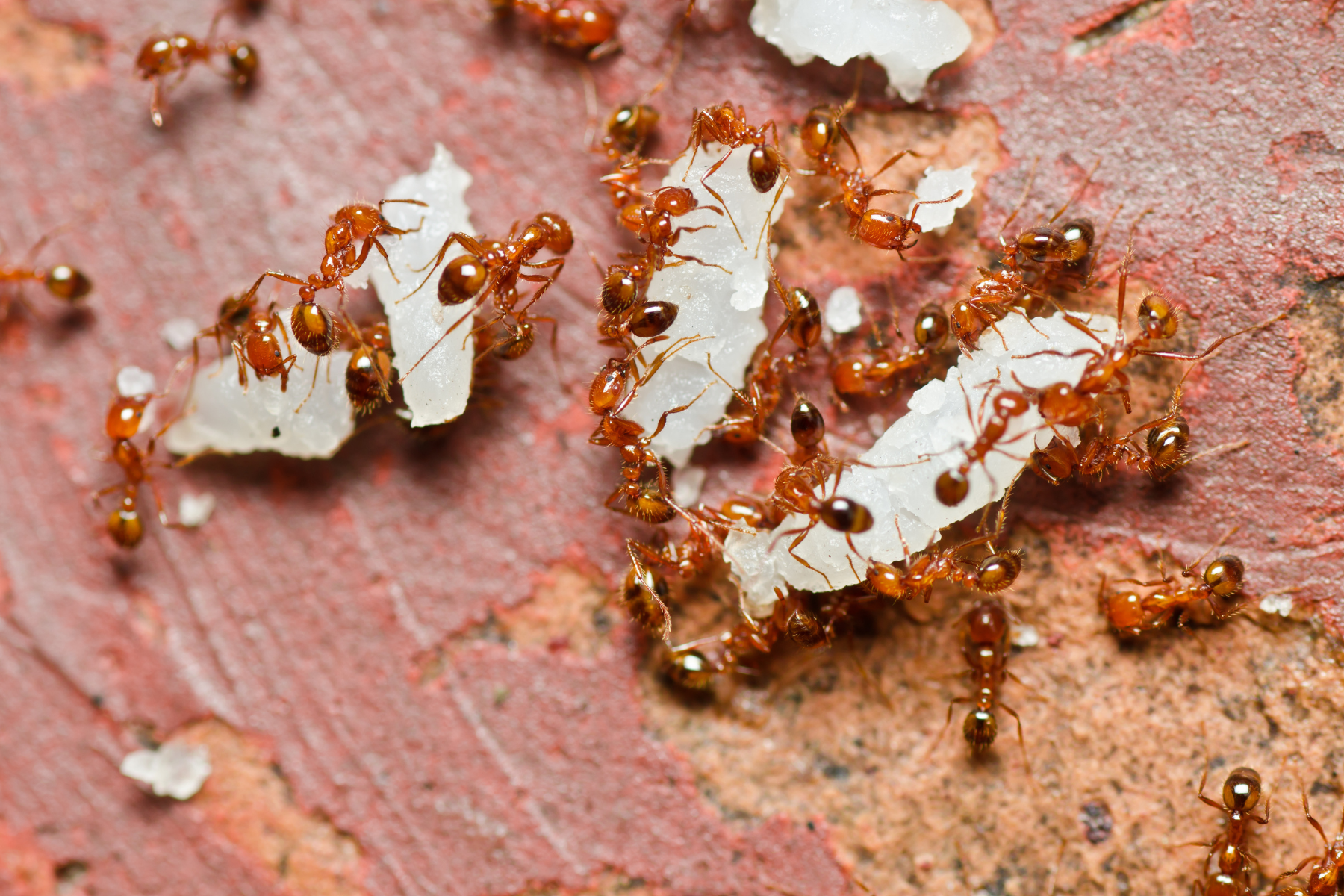The commonly found ants in Maricopa County are the Argentine ants and fire ants. Both species are major offenders. They are intrusive and persistent insects. They totally differ in behavior and control methods. One thing is for sure: do not be confused by the two of them. Yes, they’re both ants. But they have differences. Understanding it can help homeowners and property managers deal with these ant infestations. In this guide, we will break down the key differences between Argentine ants and fire ants. As well as the prevention and professional treatment strategies.
Argentine Ants vs. Fire Ants: Overview
Appearance and Size Differences
- Argentine Ants: Small (1/16 to 1/8 inch), light to dark brown, and monomorphic (all workers look the same).
- Fire Ants: Slightly larger (1/8 to 1/4 inch), reddish-brown with a darker abdomen, polymorphic (workers vary in size).
Behavior and Colony Structure
- Argentine Ants Form massive supercolonies with multiple queens. Highly cooperative between nests, which makes them hard to eliminate.
- Fire Ants: Aggressive defenders of their territory. Their colonies are usually centralized around one mound with multiple tunnels and a few queens.
Habitat and Nesting Locations
- Argentine Ants: Nest near moisture sources, under mulch, in wall voids, and under kitchen sinks.
- Fire Ants: Prefer open, sunny areas such as lawns, driveways, and building foundations. Known for building visible soil mounds.
Threat Level and Risks
Are Argentine Ants Dangerous?
Argentine ants are not harmful in terms of bites or stings, but are serious nuisances. They contaminate food, create long trails indoors, and are hard to eliminate due to their colony structure.
Are Fire Ants Dangerous?
Yes. Fire ants can sting repeatedly, injecting venom that causes painful welts. Reactions range from irritation to severe allergic responses, especially in children, pets, and sensitive individuals.
Medical Risks: Allergies and Bites
- Argentine Ants: No health risk other than possible food contamination.
- Fire Ants: Pose medical risks. Their stings may cause pustules, itching, and anaphylaxis in rare cases.
Signs of an Infestation
Indoor Signs (Argentine Ants)
- Long trails of ants along walls and baseboards
- Activity near sinks, drains, and pantry areas
- The presence of ants in bathrooms and kitchens
Outdoor Signs (Fire Ants)
- Raised mounds of dirt in lawns or garden beds
- Aggressive ant swarms when disturbed
- Red or black ants quickly emerge from the soil when stepped on
Nesting Patterns and Trails
- Argentine Ants: Spread out through wall voids, irrigation systems, and inside buildings.
- Fire Ants: Centralized mounds with aggressive behavior if disturbed.
Control Strategies for Argentine Ants
Effective Baiting Techniques
- Use slow-acting gel or liquid baits with boric acid or imidacloprid.
- Place bait stations along trails and near entry points.
- Avoid using sprays that kill on contact. They can cause the colony to split and relocate.
Indoor Prevention Tips
- Clean up spills and crumbs immediately.
- Store food in sealed containers.
- Fix leaky faucets or pipe condensation.
Environmental Modifications
- Remove mulch piles near the foundation.
- Trim bushes and trees touching the home.
- Reduce excess moisture around the property.
Control Strategies for Fire Ants
Fire Ant Mound Treatments
- Apply granular baits containing hydramethylnon or spinosad around the mound.
- Use mound drenches with insecticidal soap or bifenthrin.
- Avoid disturbing the mound before treatment.
Safety Considerations When Treating
- Always wear gloves when applying fire ant treatments.
- Keep children and pets away from treated areas until dry.
- Consider using professional-grade, pet-safe solutions.
Professional Fire Ant Management
- Licensed pest professionals can locate satellite mounds.
- Long-term monitoring and follow-up applications may be needed.
- Treatments often include broadcast baiting over the entire property.
Prevention Tips for Both Species
Argentine Ants
To stop Argentine ants from coming into your home, keep all food in tightly sealed containers. This helps because it removes smells that attract them. Clean up any spills or crumbs quickly in the kitchen and dining areas. It’s also important to close any cracks or gaps around doors and windows to stop ants from getting in. Keep your plants trimmed back so they don’t touch your house, as this can help ants climb inside. By doing these simple things, you can help keep Argentine ants away from your home.
Fire Ants
To keep fire ants out of your yard, don’t water your lawn too much. Fire ants like damp places, so it’s better to water less. Check your yard often for any ant mounds and treat them right away to stop more ants from coming. Keep your yard clean by removing piles of wood, leaves, or trash where ants can build nests. You can also use barriers or sprays around your home to keep fire ants away. By following these tips, you can help make your yard less inviting for fire ants and enjoy your outdoor space more.
When to Call a Pest Control Professional
Multiple Mounds or Trails
Seeing multiple ant mounds or indoor trails that persist despite DIY efforts is a red flag.
Bites and Health Risks
If you, a child, or a pet has been stung by fire ants, consider immediate medical care and follow-up with professional pest control.
Recurring Infestations
Both Argentine and fire ants can come back if not completely eradicated. Professionals use integrated pest management (IPM) techniques for long-lasting results.
What We Do
At Spark Pest Control, we are dedicated to protecting your home and family from unwanted pests. Our expert team combines years of experience with the latest techniques to deliver effective and safe pest control solutions. We understand that every home is unique, which is why we offer personalized services tailored to meet your specific needs. One of our proudest moments was when we helped a family in Maricopa County who had been struggling with a severe termite infestation. After a thorough inspection and treatment plan, we not only eliminated the termites but also provided ongoing monitoring to prevent future issues. The family was happy to live in their home, free from pests, and they can now enjoy their space without worry.
Stop the ants before they take over.
Don’t let Argentine or fire ants take over your home or yard! These pesky invaders can quickly turn your outdoor space into an unwelcome battleground. Protect your family and your property by taking action now. Schedule a free pest inspection with Maricopa County’s trusted ant control experts. We have the knowledge and experience to identify and eliminate ant colonies effectively. Our dedicated team will assess your situation. We will provide tailored solutions to make sure these unwanted guests don’t ruin your springtime enjoyment. Act today and reclaim your space from these relentless invaders!
Frequently Asked Questions (FAQs)
1. How can I tell the difference between Argentine ants and fire ants?
Argentine ants are smaller, light to dark brown, and form long foraging trails. Fire ants are reddish-brown, build visible mounds, and are aggressive when disturbed.
2. Are fire ants more dangerous than Argentine ants?
Yes. Fire ants can sting multiple times and inject venom, causing painful reactions or allergic responses. Argentine ants do not sting and are mostly nuisance pests.
3. What are the most effective ways to control Argentine ants?
Slow-acting baits placed near trails and entry points are effective. Avoid contact sprays that scatter colonies. Sanitation and moisture control are also essential.
4. What’s the best treatment for fire ant mounds in Arizona yards?
Use granular baits like spinosad around the mound and mound drenches such as bifenthrin. Avoid disturbing the mound before treatment.
5. Why do Argentine ants form supercolonies?
Argentine ants have multiple queens and lack intraspecies aggression, allowing them to cooperate across vast networks, which makes control more difficult.
6. Can I treat both fire ants and Argentine ants with the same product?
Not always. Fire ants often require direct mound treatment, while Argentine ants respond better to baiting and environmental changes. A targeted strategy is best.
7. What attracts Argentine ants into homes?
Moisture, sweet or greasy food, and access through cracks or unsealed entry points attract Argentine ants into homes, especially in warmer months.
8. Do fire ants only build mounds in lawns?
No. Fire ants can also nest under sidewalks, driveways, electrical boxes, and foundations, especially in sunny, dry areas.
9. How fast can either ant type reproduce?
Both species reproduce rapidly. Argentine ants have multiple queens, leading to exponential growth. Fire ant queens can lay hundreds of eggs daily.
10. When should I call a professional pest control service for ant problems?
If DIY methods fail, you see repeated infestations, multiple mounds, or if fire ant stings occur, especially around children or pets, call a licensed pest expert.



